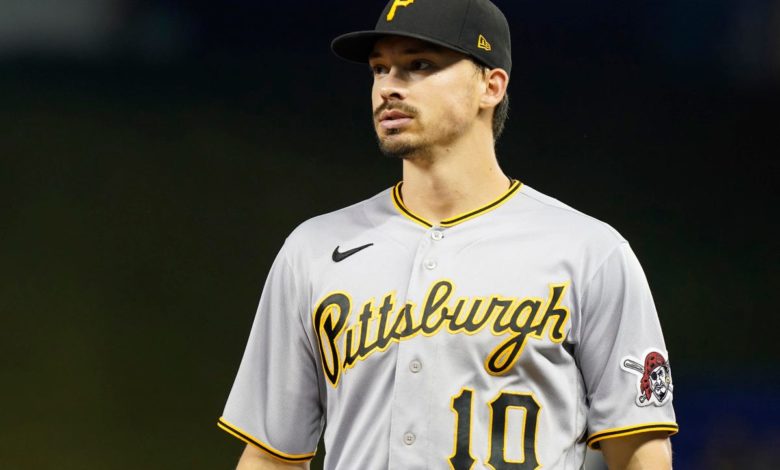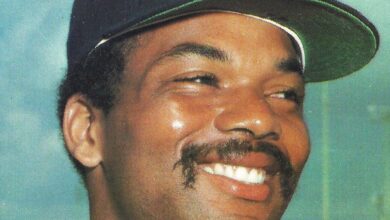
By now you’ve heard the news. After demanding a trade and weeks of negotiations seemingly headed nowhere, Pittsburgh Pirates star outfielder Bryan Reynolds has agreed to a seven-year extension that will guarantee him $100 million over the $6.75 million he’s receiving this season. It’s the largest contract in Pirates history. This, on the heels of the announcement that manager Derek Shelton‘s contract, set to expire at the end of this season, was extended as well.
Reynolds has been one of the better offensive producers in baseball since coming to the major leagues in 2019. Going into this season, he’s produced a stat line of .281/.361/.481, 74 HR, 239 RBIs and 13.5 WAR. Enough has been written about the contract. The more interesting issue is whether this signifies a new approach by Pirates owner Bob Nutting regarding expensive long-term contracts.
Who’s next?
Nutting’s remarks in announcing the Reynolds signing indicate this may be just the first step. We can interpret that to mean other star players will be tied up in long-term deals. Ke’Bryan Hayes is already locked up in his own eight-year, $70 million deal, inked before the 2022 season. We can only speculate as to who might be next. A good place to start would be tying up Oneil Cruz. Additionally, Mitch Keller and Roansy Contreras should be candidates for long-term deals. Perhaps even Jack Suwinksi and Ji Hwan Bae. Small market teams generally don’t like to lock up their closers to long-term deals. However, in the Pirates’ case, the closer is popular local product David Bednar. It will be interesting to see what develops with these players.
Nutting is generally reviled in Pittsburgh, where its denizens have labeled him the cheapest owner in sports and, absurdly, the most evil man in Pittsburgh. In my opinion, when seeking to assign blame for the Pirates’ low payroll, the culprit is not the owner but baseball’s ridiculous economic system, which, unlike other major sports, does not allow for revenue sharing, thus grossly favoring teams in the larger markets.
Want to buy a bridge?
The small market teams would be able to compete with the big boys if only their owners “wanted to win,” lament fans and experts everywhere. Meanwhile, the large market owners puff out their chests and speak of their commitment to winning. In baseball as in life, the problems of the have-nots are blamed on the have-nots.
In my day job, I work with high-net-worth individuals and business owners. I can assure you the big-spending owners do so because they believe it will ultimately lead to hefty profits. They’re not in baseball because they want to uphold some nonexistent civic duty to field a winning team or play in the ultimate fantasy league with human players as tokens. If you believe any of these wealthy owners would put winning ahead of profits, please look me up next time you’re in Pittsburgh. I’ll sell you the Bloomfield Bridge, complete with whatever cars happen to be on it at the time.
The mistakes of 2015
In 2015, the Pirates had a payroll in the neighborhood of $99 million. That was the year the Pirates won 98 games, hosted the wild card game for the third consecutive year, and lost to the hottest pitcher in baseball for the second straight year. It seemed the perfect time to add to the team and make a big push for a championship in 2016. That didn’t happen. So what did happen after 2015?
As I see it, it was less about Nutting and more about the front office. During 2011-2015, pitching coach Ray Searage and front-office pitching guru Jim Benedict had turned around the careers of pitchers A.J. Burnett, J.A. Happ, Francisco Liriano, Mark Melancon, Charlie Morton and Edinson Volquez. (Benedict was so highly regarded, the Miami Marlins would trade Trevor Williams to get him in October 2015.) In my opinion, the Pirates’ front office began to believe in their own status as geniuses.
The downward spiral
Let’s summarize some major moves made (or not made) after the 2015 season. Happ was allowed to leave and pursue free agency. Morton was traded to the Philadelphia Phillies for a suspect (the opposite of a prospect, according to Ball Four). Starting second baseman Neil Walker was traded to the New York Mets for pitcher Jon Niese. Veteran pitcher Ryan Vogelsong, a former Pirate, was reacquired as a free agent. (Volquez had been allowed to walk after the 2014 season). General manager Neal Huntington apparently believed he could acquire any pitcher and Searage would continue to work his miracles.
Of course, betting on miracles is no way to run a baseball team. Niese and Vogelsong didn’t pitch effectively often enough in 2016 and the downward spiral began. In the middle of the 2016 season. Neise was traded back to the Mets. Melancon was dealt to the Washington Nationals for Felipe Vazquez ne Rivero. Walker’s trade cleared the way for Jung Ho Kang to play regularly. Kang hit .255/.354/.513, 21 HR and 62 RBIs in 2016. Unfortunately, Kang and Vasquez would eventually run into — ahem! — legal troubles and were finished in 2019. (So was Huntington as the Pirates’ general manager.)
As frustrating as it was for Pirates fans to see the likes of Gerrit Cole and Starling Marte dealt away, spending bushels of money to keep them wouldn’t have improved the record much during the lean 2016-2022 years. Small market teams need to pick their spots when it comes to spending. Some have speculated Nutting learned his lesson in 2015 and is ready to do business differently. Skeptical Pirates fans will believe it when they see it.
“It’s a cool city.”
Let’s get back to Reynolds. Why agree to a long-term deal with a team with such an undistinguished recent past? Reynolds cited his belief in the talent the Pirates have acquired in recent years. He foresees the team becoming a winner and wants to be part of it. He also cited his love for the city of Pittsburgh. Really? Pittsburgh?
It is said Pittsburgh is like New York in that the insiders love it and the outsiders don’t understand why. Pittsburgh offers the benefits of a big city while remaining a slow-paced, friendly town. The quiet, unassuming Reynolds likes being able to go out with his wife and young children and not be bothered. Pittsburghers are generally unimpressed with celebrity. Reynolds knows this. Undoubtedly, so does actor Steve Carell. A certain actress learned the hard way.
On a recent Office Ladies podcast, when asked about his favorite city he visited in the United States, Carell said, “Pittsburgh was pretty cool. I mean, I’m not saying that ironically either. I’ve done a couple of movies there, and I liked it, and it’s a cool city.”
“Yeah, it’s the mayor.”
In 2006, actress Sienna Miller was in Pittsburgh to film The Mysteries of Pittsburgh. Apparently unaware Pittsburghers read hip publications, she made some unkind remarks about the town to Rolling Stone while there. In full damage-control mode, she called a press conference where she apologized and said some nice things about the town nobody believed she believed. Miller then posed for a picture with then-Mayor Luke Ravenstahl that appeared on the front page of the morning paper. That night, according to witnesses, she was denied entrance to Folino’s Young’s Tavern on the South Side because of the lack of an ID proving her age. A. Miller stomped on the sidewalk, yelling, “I am a famous actress!” her mother showed the newspaper to the bouncer, asking, “Don’t you know who this is?”
“Yeah,” shrugged the bouncer. “It’s the mayor.”





